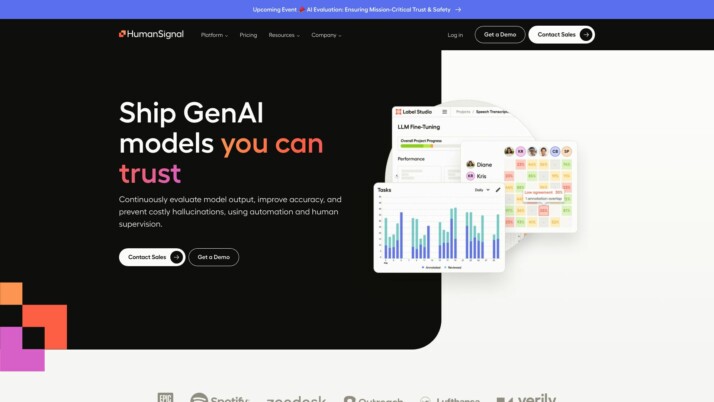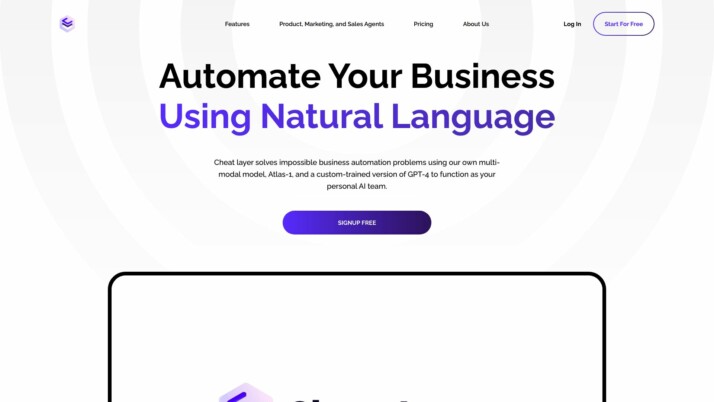Adala vs. Cheat Layer: Feature Comparison
In today’s fast-paced AI ecosystem, the demand for accessible yet powerful solutions continues to surge. Whether you’re a developer seeking advanced customization or a non-technical user prioritizing accessibility, finding the right platform to harness the potential of AI agents is essential.
Our comprehensive guide explores the capabilities of Adala vs. Cheat Layer, and our own SmythOS, empowering you to make an informed decision tailored to your specific needs.
Adala Overview
Adala is an innovative open-source framework designed to create autonomous data labeling agents. These agents leverage large language models like GPT-3 to acquire specialized skills such as text classification, summarization, and question answering. By interacting with labeled datasets and incorporating human feedback, Adala’s agents continuously refine their capabilities, ensuring reliable and adaptable results.
One of Adala’s key strengths lies in its modular architecture, enabling users to extend the framework’s functionality through community contributions. This collaborative approach fosters a rich ecosystem of skills, runtimes, datasets, and environments tailored to diverse data labeling needs.


Adala’s vision is to increase the efficiency and cost-effectiveness of data labeling processes while maintaining high quality standards. By seamlessly integrating AI and human guidance, the framework promises to streamline workflows and deliver consistent, trustworthy outcomes across various domains.
Cheat Layer Overview
Cheat Layer is a pioneering automation platform that leverages cutting-edge AI to provide innovative business automation solutions. At the core of Cheat Layer lies their custom-trained version of GPT-4 and the powerful multi-modal model Atlas-1, enabling users to generate automations with unlimited complexity through simple natural language interactions. This makes the platform highly accessible, even for non-technical users.
One of Cheat Layer’s standout features is the Project Atlas Framework, which allows users to create end-to-end automation solutions by conversing with the system as if they were speaking to an engineer. This natural language interface streamlines the process of building complex automations, making it a valuable tool for businesses seeking efficiency and productivity gains.


Cheat Layer also offers Semantic Targets, a robust feature that ensures automations remain functional even when the services they interact with undergo design changes. By defining automation targets using natural language, Cheat Layer delivers future-proof solutions that maintain accuracy and longevity.
Cheat Layer aims to remove barriers to business creation and operation, fostering an environment where quality service and personal relationships drive success.
One of the most compelling aspects of Cheat Layer is its accessibility. The platform provides 1-Click Cloud Agents that users can deploy directly from their mobile devices, enabling seamless automation of tasks such as content generation, A/B testing, and lead generation with minimal setup. Additionally, the Live Mode feature allows users to iteratively build and deploy products like apps and landing pages, ensuring real-time feedback and alignment with intended goals.
For users without coding experience, Cheat Layer offers a no-code interface with a drag-and-drop editor, simplifying the creation of custom automations. Moreover, the platform’s White Label Solutions enable agencies to create and resell branded automation solutions, further expanding the reach of this powerful technology.
At its core, Cheat Layer envisions a future where AI democratizes business automation, enabling small businesses to compete with larger enterprises by leveraging powerful, accessible, and cost-effective automation tools. Cheat Layer aims to remove barriers to business creation and operation, fostering an environment where quality service and personal relationships drive success.
Feature Comparison
Adala and Cheat Layer have distinct differences in their feature sets, reflecting their unique approaches to AI agent development. While Adala focuses primarily on autonomous data labeling agents, Cheat Layer presents itself as a comprehensive automation platform with extensive capabilities.
Adala’s core functionality revolves around creating agents that can acquire specialized skills like text classification, summarization, and question answering. These agents learn and improve through interactions with labeled datasets and human feedback. However, Adala lacks features like hosted agents, development/production environments, visual builders, and no-code interfaces, making it more suitable for users with coding experience.
While Adala focuses on a specific domain of autonomous data labeling agents, Cheat Layer presents itself as a more comprehensive automation platform with a broader range of features and deployment options.
In contrast, Cheat Layer offers a robust suite of features that cater to a broader audience. Its visual builder, no-code interface, and extensive integrations with APIs and automation tools make it accessible to users with varying technical backgrounds. Cheat Layer also supports hosted agents, staging and production environments, and deployment options like APIs, webhooks, and site chats, enabling more flexible and scalable implementations.
While Adala emphasizes autonomous agents for data labeling tasks, Cheat Layer’s agents can tackle a wider range of automation and problem-solving scenarios. Cheat Layer’s agents can operate autonomously, collaborate with other agents, and leverage multimodal capabilities, making them versatile for various use cases.
Regarding security and transparency, Cheat Layer appears to have a more comprehensive offering, with features like constrained alignment, data encryption, OAuth support, and audit logs for analytics. Adala, on the other hand, lacks explicit mentions of these security and transparency features in its documentation.
Both platforms support integrations with foundation AI models and APIs, but Cheat Layer extends its capabilities by incorporating Zapier APIs and other RPA tools. Additionally, Cheat Layer offers features like logic components and data lake support, which are not explicitly mentioned in Adala’s documentation.
In summary, while Adala focuses on a specific domain of autonomous data labeling agents, Cheat Layer presents itself as a more comprehensive automation platform with a broader range of features and deployment options. Cheat Layer’s visual builder, no-code interface, and extensive integrations make it a more accessible solution for users with varying technical backgrounds, while its advanced features cater to complex automation and problem-solving scenarios.
Feature Comparison Table
| Adala | Cheat Layer | SmythOS | |
|---|---|---|---|
| CORE FEATURES | |||
| AI Agents? | ❌ | ✅ | ✅ |
| Problem-Solving Capabilities | ❌ | ✅ | ✅ |
| Autonomous Agents | ❌ | ✅ | ✅ |
| Memory & Context | ❌ | ✅ | ✅ |
| Hosted Agents (Dev, Production) | ❌ | ✅ | ✅ |
| Environments (Dev, Production) | ✅ | ✅ | ✅ |
| Multi-Agent Collaboration | ❌ | ❌ | ✅ |
| Multimodal | ❌ | ✅ | ✅ |
| Explainability and Transparency | ❌ | ✅ | ✅ |
| Debug Tools | ❌ | ✅ | ✅ |
| SECURITY FEATURES | |||
| Data Encryption | ❌ | ✅ | ✅ |
| Constrained Alignment | ❌ | ✅ | ✅ |
| OAuth | ❌ | ✅ | ✅ |
| COMPONENTS | |||
| Foundation AIs | ❌ | ❌ | ✅ |
| Logic | ❌ | ✅ | ✅ |
| DEPLOYMENT OPTIONS (EMBODIMENTS) | |||
| API Auth (OAuth + Key) | ❌ | ✅ | ✅ |
| Deploy as API | ❌ | ✅ | ✅ |
| Scalability | ❌ | ✅ | ✅ |
| DATA LAKE SUPPORT | |||
| Hosted Vector Database | ❌ | ✅ | ✅ |
While both Adala and Cheat Layer offer innovative solutions for AI agent development, SmythOS emerges as the superior alternative for most use cases. Its comprehensive feature set, including a visual builder, extensive AI model integration, flexible deployment options, and robust security protocols, positions SmythOS as a versatile platform that caters to a wide range of users. From developers seeking advanced customization to business users prioritizing accessibility, SmythOS provides the tools and frameworks necessary to create and deploy intelligent agents efficiently. With its scalable architecture, commitment to ethical AI practices, and a strong emphasis on user-friendliness, SmythOS stands out as the go-to choice for those seeking to unlock the full potential of AI agents.
Conclusion
SmythOS stands out as the premier platform for creating and deploying intelligent agents across a wide range of use cases. With its robust feature set, including a visual builder, extensive integrations with AI models and APIs, and versatile deployment options, SmythOS empowers individuals and businesses to unlock the full potential of AI.
Whether you’re a developer seeking advanced customization, a business leader prioritizing scalability and security, or a non-technical user in search of user-friendly tools, SmythOS caters to your needs. Its intuitive drag-and-drop interface, combined with pre-built AI templates, streamlines the development process, making AI accessible to users of all skill levels.
Furthermore, SmythOS embraces the principles of ethical AI, ensuring that agents operate within predefined constraints and adhere to best practices for transparency and accountability. With its commitment to security, data encryption, and authentication protocols, SmythOS provides a trusted environment for deploying mission-critical AI solutions.
As you explore the vast possibilities of AI, we invite you to experience the power and flexibility of SmythOS. Create your free Smyth account to browse agent templates and discover how SmythOS can revolutionize your workflows and drive innovation within your organization. Don’t hesitate to explore our subscription options and read glowing testimonials from our satisfied customers.
Last updated:
Disclaimer: The information presented in this article is for general informational purposes only and is provided as is. While we strive to keep the content up-to-date and accurate, we make no representations or warranties of any kind, express or implied, about the completeness, accuracy, reliability, suitability, or availability of the information contained in this article.
Any reliance you place on such information is strictly at your own risk. We reserve the right to make additions, deletions, or modifications to the contents of this article at any time without prior notice.
In no event will we be liable for any loss or damage including without limitation, indirect or consequential loss or damage, or any loss or damage whatsoever arising from loss of data, profits, or any other loss not specified herein arising out of, or in connection with, the use of this article.
Despite our best efforts, this article may contain oversights, errors, or omissions. If you notice any inaccuracies or have concerns about the content, please report them through our content feedback form. Your input helps us maintain the quality and reliability of our information.
